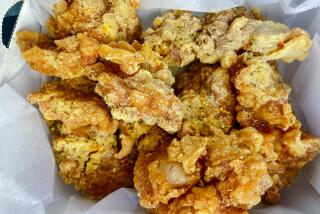Viva la Brasa
Peruvian cooking can be among the most varied in South America, complexly seasoned, intensely regional, drawing exotic fruit from the Amazon jungles and tubers from the highest mountains, meat from the great Andean plains, superb cold-water fish from the frosty Magellan Current that runs along the coast.
Parihuela, a sort of highly flavored Peruvian bouillabaisse, may be the greatest fish stew of the Americas, Chinese-Peruvian “chifa” cooking the most fully integrated of American-Asian cuisines.
But in Los Angeles’ Spanish-speaking communities, the word “Peruvian” on a restaurant sign is essentially a code word implying rotisserie chicken: plump, crackling birds marinated with garlic and chiles and roasted brown over a live hardwood fire. El Pollo Inka established something of a restaurant empire in the South Bay on the strength of its great roast chicken; the chicken slingers at Pollo Tumis serve the birds of choice in Hollywood.
There are scads of popular Peruvian chicken stands in East L.A., Pomona, Huntington Park, Inglewood. Peruvian-style chicken--sometimes called pollo a la brasa, chicken on a spit--is the stuff to turn to when you’re looking for roasted chicken with lots of taste.
The first thing you notice about Pollo a la Brasa, a Peruvian chicken joint on a traffic island near the edge of Koreatown, is the wood smoke, great billowing draughts that perfume downwind noodle shops and coffee bars, make the nearby Salvadoran cafes smell as if they served barbecue instead of pupusas and occasionally offer a whiff of disaster in the night to high-floor apartment dwellers. Split logs are piled everywhere--behind the restaurant, blocking the front door, behind fences and in the kitchen, spilling over onto half the square footage of the wedge-shaped parking lot.
Inside Pollo a la Brasa, a tiny takeout place that seems no smokier than, say, the inside of a chimney, there’s an assembly line in the back, guys impaling chickens onto thick steel skewers, jamming threaded chickens into a vast, flame-licked apparatus, hacking chickens into parts with the dexterity of machete-wielding orthopedists and tossing them onto piles of French fries. Chicken and fries: That’s what you get.
The chicken here is remarkable, well garlicked, slightly spicy, marked with pungent smoke, clearly the marriage of a chicken and a bunch of logs. The softness of the meat betrays slight over-marination, but the flesh is juicy, the herbal flavor clear, the skin caramelized and crisp.
With the chicken comes a standard salad, also little plastic cups of aji, a smooth mint-green chile puree that is almost hot enough to sear the skin off your lips. The fries are made from fresh-cut potatoes, but in that limp, peculiarly Latin American style that accentuates the musky sweetness of potatoes rather than their potential crispness. To drink, the usual cans of Inca Kola and the Peruvian purple corn beverage chicha morada, which always sounds more exotic than the vaguely clove-scented Kool-Aid it turns out to be.
There is also a little-tended grill devoted to anticuchos, garlicky little shish kebabs of beef heart. In Lima, fast-food entrepreneurs manage to get beef heart to taste better than steak--smoky, a little blackened, as meltingly juicy as prime filet.
The anticuchos here, while on the rubbery side, may not be quite the charbroiled pencil-erasers you’ll find as appetizers at certain South Bay Peruvian restaurants but are probably not the dish that will persuade you that cow organs are worth eating.
(BEGIN TEXT OF INFOBOX / INFOGRAPHIC)
WHERE TO GO
Pollo a la Brasa, 764 S. Western Ave., Los Angeles; (213) 382-4090. Also at 16527 S. Vermont Ave., Gardena; (310) 715-2494. Open daily for lunch and dinner. Cash only. No alcohol. Extremely limited lot parking. Takeout. Dinner for two, food only, $5 to $10.
WHAT TO GET
Roast chicken.



